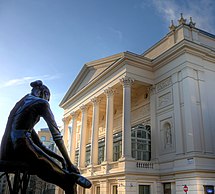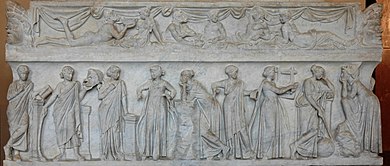 |
| Theatre Royal Drury Lane 1821 Source Wikipedia |
This is the fourth in my series of articles on ballet and branding which is my thank you to companies, theatres and dancers for a lifetime of pleasure watching their performances. The others are
"Ballet as a Brand? How to bring More Money into Dance for Companies and Dancers" 13 March 2014,
"Protecting the Brand" 31 March 2014 and
"Branding and Ballet - Licensing the Brand" 18 April 2014. In this article I shall discuss two important
intellectual property rights (
"IPR") for companies, theatres and dancers:
copyrights and
rights in performances.
What is IP?
Intellectual property (
"IP") is a portmanteau terms for the bundle of laws that protect investment in
intellectual assets. Intellectual assets are creations of the mind that give one business a competitive advantage over all others. Such assets can be a new invention, a blockbuster film or novel, the cachet that is given to luxury product and so on.
Intellectual assets fall into four categories:
- Brands
- Design
- Technology, and
- Works of art and literature.
The laws that protect the investment in creating those assets in the UK include the
Patents Act 1977, the
Copyright, Designs and Patents Act 1988 ("CDPA") and the
Trade Marks Act 1994. The rights that those laws confer, such as
patents for inventions,
copyrights in original works of art and literature and registered trade marks for signs that distinguish one business's goods or services from those of all others are types of IPR (intellectual property rights).
The exercise of those rights can be very valuable for a business which is why we regard them as property. As they protect creations of the mind or intellect we call them intellectual property.
Copyrights and Rights in Performances
The intellectual assets that copyrights and rights in performances protect are works of art and literature.
Copyrights have existed in one form or another since the days of Queen Anne. The first copyright statute for this country is still referred to as
The Statute of Anne. Copyrights prevent the unauthorized copyright, distribution, performance and other exploitation of works that are written, drawn or otherwise created in some permanent medium such as film or optical or magnetic memory.
Rights in performances are much more recent. These protect the performances of actors, musicians, dancers and other performers from unauthorized broadcasting, filming or taping and other exploitation of their performances. The existence of those rights has only been possible since the development of sound and motion picture recording and transmission technologies.
The CDPA
International Agreements
Copyright Works
The CDPA protects the following types of work from unauthorized copying, publishing, performance and other distribution in the UK:
- Original artistic, dramatic, literary and musical works
- Broadcasts, films and sound recordings, and
- Typographical arrangements of publications.
That covers such works as the story, score, the choreology, broadcasts and HDTV transmissions and some of the art work such as scenery and fabric designs. One of the many things that the Court of Appeal decided in Massine v De Basil[1936 - 1945] MCC 233, one of the few copyright cases relating to ballet, was that there is no such thing as copyright in a ballet. There are instead a bundle of copyrights in the works that make up a ballet such as an outline of the plot, the music, notation, artwork for the scenery, costumes and other works. Secondary copyrights are created in any videos that are made during class and rehearsals as well as in any sound recordings that may be made. Yet more copyrights are made in the notes, photos, compilation, editing and typographical arrangement of the programmes.
Rights in Performances
Performers including dancers and those who have contracted with a dancer or other performer to broadcast, film or tape a performance such as the BBC, a film studio or a record company have the right to object to the broadcasting, filming or taping of a performance regardless of whether the performance takes place in a theatre, TV studio or film set.
Creating a Copyright?
There is no system of copyright registration in the UK though there is in some other countries. Copyrights come into being the moment a work in which copyright can subsist is created by a British citizen or resident or a citizen or resident of any other state that confers confers protection on the works of British citizens and residents within its territories pursuant to the Berne Convention or some other agreement with the UK government. Most countries of the world are party to Berne and the few that are not have entered other multi or bilateral agreements with the UK.
Copyright can subsist in any of the works listed above provided that it is not copied wholly from another work. Essentially copyright rewards the labour, skill and taste that has been expended on a work. Thus, a poet may write a poem which creates a literary copyright; an artist a drawing that creates an artistic copyright; and an editor may choose the poem and the drawing and combine them with other poems and drawings in an anthology which creates yet another literary copyright in the compilation.
Creating a Right in a Performance
Consent is required for broadcasting, filming or taping of a performance from the moment the dancer or other performer walks on stage to the final curtain call so long as the performance takes place in the UK or by a national of a country that is party to the Rome Convention or some agreement with the UK.
Who owns Copyright?
Usually the author (that is to say the person who makes the work) is the first owner of the copyright subsisting in the work but there are a number of exceptions. If the author is employed to create the work under a contract of employment or apprenticeship the author's employer becomes the first owner unless the employer and employee have agreed otherwise. Merely commissioning a work, however, does not usually confer copyright on the commissioner unless the circumstances suggest that that is what the parties had intended as happened in
Massine v de Basil. When commissioning a score, choreography or other work it is important for the parties to think about who is to own the work and what rights (if any) each of the parties has or should have in its exploitation.
Who owns a Right in a Performance?
In the first instance it is up to the dancer or other performer to consent to the broadcasting, filming, taping or other exploitation of his or performance. In practice the terms upon which such consent is given have been negotiated by
Equity on behalf of its members. Such terms are incorporated into individual performers' contracts of employment. Broadcasters, film and recording studios that have negotiated exclusive contracts to record a performance can also object to broadcasting, filming and taping of performances.
How to make Money from Copyrights and Rights in Performances
Copyrights and rights to make, distribute and otherwise exploit copies of recordings may be assigned or licensed for money or moneysworth. How much will be paid by way of a royalty, licence fee or other payment will depend on supply and demand. The work of a well known artist, choreographer or composer will generally command a greater payment than that of a lesser known one. Some copyright owners assign their rights to organizations known as "collecting societies" which collect payments on behalf of all their members and distribute them after deducting their expenses as individual dividends.
BECS (British Equity Collecting Society) collects royalties for licensing performers' rights on behalf of their members.
Moral Rights
In addition to the rights mentioned above which are generally referred to as "economic rights" performers and some copyright owners have rights to be identified as performer or author and the right to object to derogatory treatment of their works that are known as "moral rights". These subsist quite independently of the economic rights and cannot be assigned.
Enforcement
Violation of an IPR is known as "infringement".
Large scale deliberate infringement of copyright (known as "piracy") and rights in performances ("bootlegging") are offences that can be punished by up to 10 years imprisonment and an unlimited fine. Local authority trading standards officers have a statutory duty to investigate and prosecute such offences.
IPR owners can also sue infringers in the civil courts for injunctions (orders of the court to refrain from or stop infringements on pain of fine or imprisonment for disobedience), damages (compensation for past infringements) or an account of profits (disgorging any profits that have been made from infringements), surrender of infringing copies and their costs (legal expenses for bringing the action). In England and Wales most claims for IPR infringement (including small claims) are brought in the Intellectual Property Enterprise Court (
"IPEC") or the Intellectual Property list of the Chancery Division of the High Court of Justice.
Collecting societies also bring proceedings in the civil courts on behalf of their members.
Further Reading
The Intellectual Property Office has published a very useful guide entitled
"Copyright, Essential Reading" which can be downloaded in pdf from its website. Equity also has a considerable volume of materials on performers' rights which is accessible to its members.
Should anyone require additional information he or she can call me during office hours on 020 7404 5252 or send me a message through my
contact form,
twitter,
Facebook,
G+,
Linkedin or
Xing.
Happy May bank holiday everybody.









.jpg/220px-Cotton_Tree_(Sierra_Leone).jpg)





